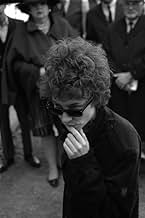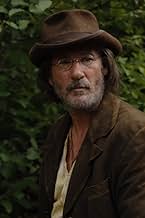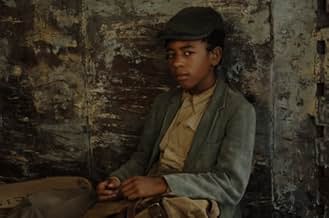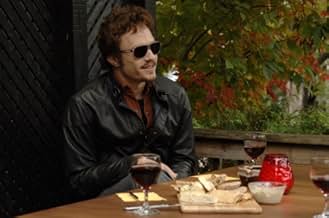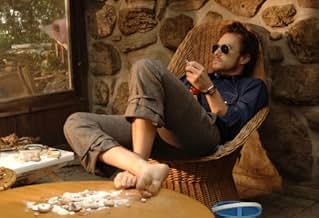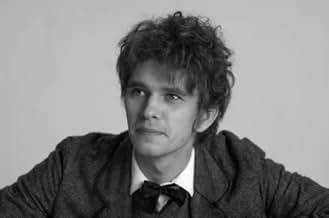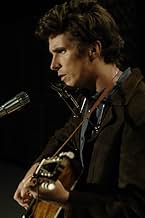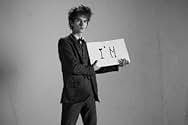AVALIAÇÃO DA IMDb
6,8/10
63 mil
SUA AVALIAÇÃO
Ruminações sobre a vida de Bob Dylan, onde seis personagens personificam um aspecto diferente da vida e da obra do músico.Ruminações sobre a vida de Bob Dylan, onde seis personagens personificam um aspecto diferente da vida e da obra do músico.Ruminações sobre a vida de Bob Dylan, onde seis personagens personificam um aspecto diferente da vida e da obra do músico.
- Direção
- Roteiristas
- Artistas
- Indicado a 1 Oscar
- 29 vitórias e 49 indicações no total
Kris Kristofferson
- Narrator
- (narração)
Roc Lafortune
- Hobo Moe
- (as Roc LaFortune)
Brian R.C. Wilmes
- Circus Man
- (as Brian RC Wilmes)
Avaliações em destaque
'I'm Not There' Todd Haynes, 2007
The biopicture can be a difficult kind of picture to picture. Even more so when you have no intention of divulging the name of your subject. And dare I say it, yet further still when you insist on casting at least six people to play the lead role. This is the charm behind 'I'm Not There' - Todd Haynes' tribute to the life and times of Bob Dylan that recently lit up the Festival di Venezia. Biographic cinema is a frightening beast, some films are stuffed full of information while others attempt to exactly mimic their respective studies. There are however very few that play with their quarry, flitting from fact to fiction so quickly that in the end we know not what to believe. In reality, the life of Robert Dylan was exactly this mess of lies, grandeur, childishness, arrogance and genius. One of almost unbelievable occurrences that when whispered about long enough become carefully set in stone. Todd Haynes understands this fact and so goes after it with a stance of almost awed respect, yet as an onlooker - crafting a mockumentary that is so rich in character and love and attention to detail that we can't help but be drawn in. I've heard early reviews stating that 'I'm Not There' will make the Dylanites gush and the normal folk sleep. The fact is this couldn't be further from the truth - being a person that is indifferent to the music appears only to heighten the enjoyment.
Somewhere during the last five years, writer/director Haynes came upon the slightly trampled idea of conducting a Bob Dylan biography movie. Nothing original in itself, though with one idea to make it slightly different from what the likes of Scorsese had attempted a few years back. He would use multiple actors for 'I'm Not There', six in fact - to portray the iconic figure. And what an inspired decision it is. The unrecognisable and slender form of Cate Blanchett steals the show, melting into her eye-rubbing, nose-twitching, lip-conscious take that is only too quick to lash those in proximity with a witful tongue. Almost as idiosyncratic is Ben Whishaw's sarcasm-laced drawling poet Dylan. Who prompts guffaws when tiresomely declaring his name as "R-I-M-B-A-U-D" to an arresting police officer. The eccentric duo are displayed primarily in overexposed black and white, and complementing this in Technicolor are the equally impressive Christian Bale and Heath Ledger. Whom fall upon the unwashed, shaded rocker Dylan with equally strong performances. To complete the musical sextuplets are Richard Gere and the delightful Marcus Carl Franklin, these two are the tall-tale Dylans. A jaded western cowboy and a blues-singing black child respectively, both adding another more fictional dimension to the character. They are almost opposite ends of the Dylan-spectrum, and are introduced at the opening and closing of the film to further embolden this point. Franklin in particular impresses, tugging at the humor strings again with his dry recollections of a life on the musical road.
The host of supporting actors/actresses in 'I'm Not There' do well to further the films themes. With Charlotte Gainsbourg and Julianne Moore taking up the posts of drama and documentary accordingly. Each plays one of the two most important women in Dylan's life, with Gainsbourg (Sara Lownds) cooking up a memorable on-screen chemistry - or lack thereof - with Ledger's character. She is instantly attractive across a smoky diner, yet this attraction soon wanes as romance stagnates. Never-ending tours take their toll and the once exciteful, scooter-riding relationship crumbles. Moore's character (Joan Baez) is more reflective, playing her whole part as if interviewed enthusiastically many years on. My only problem is with the later segments of 'I'm Not There'. Particularly those featuring the bearded and bespectacled Richard Gere. Many know the story of Pat Garrett and Billy the Kid, and this part is essential when regarding the plot. My qualm is that it feels almost tacked on as an afterthought, trotting outside the clear themed borders that the film has laid out so meticulously. This only adds to the ballooning length of the film, and so did begin to drag during these Wild-western plot points. That said, this hardly takes away from an experience that is both visceral and enlightening. Comedic and pensive. Wild and tender. A life, in all possible senses of the word.
9/10
The biopicture can be a difficult kind of picture to picture. Even more so when you have no intention of divulging the name of your subject. And dare I say it, yet further still when you insist on casting at least six people to play the lead role. This is the charm behind 'I'm Not There' - Todd Haynes' tribute to the life and times of Bob Dylan that recently lit up the Festival di Venezia. Biographic cinema is a frightening beast, some films are stuffed full of information while others attempt to exactly mimic their respective studies. There are however very few that play with their quarry, flitting from fact to fiction so quickly that in the end we know not what to believe. In reality, the life of Robert Dylan was exactly this mess of lies, grandeur, childishness, arrogance and genius. One of almost unbelievable occurrences that when whispered about long enough become carefully set in stone. Todd Haynes understands this fact and so goes after it with a stance of almost awed respect, yet as an onlooker - crafting a mockumentary that is so rich in character and love and attention to detail that we can't help but be drawn in. I've heard early reviews stating that 'I'm Not There' will make the Dylanites gush and the normal folk sleep. The fact is this couldn't be further from the truth - being a person that is indifferent to the music appears only to heighten the enjoyment.
Somewhere during the last five years, writer/director Haynes came upon the slightly trampled idea of conducting a Bob Dylan biography movie. Nothing original in itself, though with one idea to make it slightly different from what the likes of Scorsese had attempted a few years back. He would use multiple actors for 'I'm Not There', six in fact - to portray the iconic figure. And what an inspired decision it is. The unrecognisable and slender form of Cate Blanchett steals the show, melting into her eye-rubbing, nose-twitching, lip-conscious take that is only too quick to lash those in proximity with a witful tongue. Almost as idiosyncratic is Ben Whishaw's sarcasm-laced drawling poet Dylan. Who prompts guffaws when tiresomely declaring his name as "R-I-M-B-A-U-D" to an arresting police officer. The eccentric duo are displayed primarily in overexposed black and white, and complementing this in Technicolor are the equally impressive Christian Bale and Heath Ledger. Whom fall upon the unwashed, shaded rocker Dylan with equally strong performances. To complete the musical sextuplets are Richard Gere and the delightful Marcus Carl Franklin, these two are the tall-tale Dylans. A jaded western cowboy and a blues-singing black child respectively, both adding another more fictional dimension to the character. They are almost opposite ends of the Dylan-spectrum, and are introduced at the opening and closing of the film to further embolden this point. Franklin in particular impresses, tugging at the humor strings again with his dry recollections of a life on the musical road.
The host of supporting actors/actresses in 'I'm Not There' do well to further the films themes. With Charlotte Gainsbourg and Julianne Moore taking up the posts of drama and documentary accordingly. Each plays one of the two most important women in Dylan's life, with Gainsbourg (Sara Lownds) cooking up a memorable on-screen chemistry - or lack thereof - with Ledger's character. She is instantly attractive across a smoky diner, yet this attraction soon wanes as romance stagnates. Never-ending tours take their toll and the once exciteful, scooter-riding relationship crumbles. Moore's character (Joan Baez) is more reflective, playing her whole part as if interviewed enthusiastically many years on. My only problem is with the later segments of 'I'm Not There'. Particularly those featuring the bearded and bespectacled Richard Gere. Many know the story of Pat Garrett and Billy the Kid, and this part is essential when regarding the plot. My qualm is that it feels almost tacked on as an afterthought, trotting outside the clear themed borders that the film has laid out so meticulously. This only adds to the ballooning length of the film, and so did begin to drag during these Wild-western plot points. That said, this hardly takes away from an experience that is both visceral and enlightening. Comedic and pensive. Wild and tender. A life, in all possible senses of the word.
9/10
This was the semantically richest and emotionally deepest film experience I have had in years. And since I am different now that I was five years ago, it could qualify as near my favorite. It will likely not be so for you, at least to approach the way I did. It seems that you have to be my age, and have lived through the events the wrap this. Also, you have to have invested some part of your personal poetry in that of this man. And finally, you have to be sufficiently cineliterate to follow the amazing shape of the eye-concepts that are serially birthed.
Often I say that essentially all films are about other films, rarely reaching life. This does that, reaching life, but by going through, punching through art by force. It presents a collage of images in such a way that we can see through the space in them to truth. Its an amazing feat. But in order for it to work, you have to have those patches sparkle for you.
So for instance you have to have internalized Fellini's one masterpiece, and be yearning for decades to escape the now close confines of the imagination set then. Of course when it was new, it was a wild ramble in the jungle, but now turn to tethers in the park. You really have to chafe at what passes for cinematic art, and dream of the next film, the one that will do for us what "8 1/2" did then.
You also have to have lived through the blasphemy of the Vitenam war and ideally have been on the "right side" throughout and still bear the pain of it. You have to seriously, even though the director is too young for this have had your life ruined by the revelation of a lying government, coupled with the spinning parade of false hopes from artists, many of whom we still admire. You have to have built your life taking into account mistrust.
But you also have to have had this particular dancer as a focus. This man who split into so many men, most of whom were designed to charm, all of whom weren't men at all but crystallized paths to salvation. You have to have invested in a few of these paths yourself enough so that it cost you more than it ever could Dylan.
If you have all of these traits then you already have the web on which this tarantula dances. And this will seep into you like some exotic solvent carrying subtle hallucinogens. And it will haunt you forever. Oh, you'll be able to slough it off and pretend that this is merely a clever puzzle of kinematic trivia. But this will hurt. It will hurt a lot, but only because of memories now defused.
It will make you soar as well, because it is so massively glorious. Many Dylans, well of course. Different ages, races, sexes. My, surely true.
Stories about films of one in another, about hiding from each other, about having sex with and spatting with each other. About disowning, and writing about each other. About one being another's blood, who is the hidden eyebrow of another in a Joycean web, but one that makes sense because it is made out of the stuff that made us.
What impresses me so much is that even before this was conceived the filmmaker had to know something like this fabric of selves existed. And he had to without having lived it himself develop deep intuitions about how this specific soul danced upon us in music and images. He had to understand how to borrow and bend those images with the music in ways that would make Julie Taymor blush: "Thin Man" used not for confused sexual tension but the conflating of superficial dylanology with artistic expiration. "Pat Garrett" as the context for a world rather than the escape from one. Over and over again the juxtapositions of life events, image and music (often performed by others in strange deviations) are all wrong but so right.
And then this artist had to see it all cinematically, to send it directly into our soul. I suppose this is a particularly broad leap because of the disconnected way this must have been made.
I celebrate this. You might wonder if it worked for someone, somewhere. It sure did for me.
Cate understands the whole enterprise, from the outside, all the way through every layer. What a soul!
Ted's Evaluation -- 4 of 3: Every cineliterate person should experience this.
Often I say that essentially all films are about other films, rarely reaching life. This does that, reaching life, but by going through, punching through art by force. It presents a collage of images in such a way that we can see through the space in them to truth. Its an amazing feat. But in order for it to work, you have to have those patches sparkle for you.
So for instance you have to have internalized Fellini's one masterpiece, and be yearning for decades to escape the now close confines of the imagination set then. Of course when it was new, it was a wild ramble in the jungle, but now turn to tethers in the park. You really have to chafe at what passes for cinematic art, and dream of the next film, the one that will do for us what "8 1/2" did then.
You also have to have lived through the blasphemy of the Vitenam war and ideally have been on the "right side" throughout and still bear the pain of it. You have to seriously, even though the director is too young for this have had your life ruined by the revelation of a lying government, coupled with the spinning parade of false hopes from artists, many of whom we still admire. You have to have built your life taking into account mistrust.
But you also have to have had this particular dancer as a focus. This man who split into so many men, most of whom were designed to charm, all of whom weren't men at all but crystallized paths to salvation. You have to have invested in a few of these paths yourself enough so that it cost you more than it ever could Dylan.
If you have all of these traits then you already have the web on which this tarantula dances. And this will seep into you like some exotic solvent carrying subtle hallucinogens. And it will haunt you forever. Oh, you'll be able to slough it off and pretend that this is merely a clever puzzle of kinematic trivia. But this will hurt. It will hurt a lot, but only because of memories now defused.
It will make you soar as well, because it is so massively glorious. Many Dylans, well of course. Different ages, races, sexes. My, surely true.
Stories about films of one in another, about hiding from each other, about having sex with and spatting with each other. About disowning, and writing about each other. About one being another's blood, who is the hidden eyebrow of another in a Joycean web, but one that makes sense because it is made out of the stuff that made us.
What impresses me so much is that even before this was conceived the filmmaker had to know something like this fabric of selves existed. And he had to without having lived it himself develop deep intuitions about how this specific soul danced upon us in music and images. He had to understand how to borrow and bend those images with the music in ways that would make Julie Taymor blush: "Thin Man" used not for confused sexual tension but the conflating of superficial dylanology with artistic expiration. "Pat Garrett" as the context for a world rather than the escape from one. Over and over again the juxtapositions of life events, image and music (often performed by others in strange deviations) are all wrong but so right.
And then this artist had to see it all cinematically, to send it directly into our soul. I suppose this is a particularly broad leap because of the disconnected way this must have been made.
I celebrate this. You might wonder if it worked for someone, somewhere. It sure did for me.
Cate understands the whole enterprise, from the outside, all the way through every layer. What a soul!
Ted's Evaluation -- 4 of 3: Every cineliterate person should experience this.
This movie can be difficult to follow if you are not familiar with Bob Dylan, but it is in fact a carefully and lovingly crafted tribute, that aims to reflect the essence of the artist's work and life. It is a fun take on its subject, though in order to be fully appreciated, one has to know what is being explored. Otherwise, it may seem a tedious watch, but perhaps that is appropriate as in order to fully appreciate Bob Dylan, one has to pay attention, and then it becomes quite rewarding. The shape-shifting nature of Bob Dylan has been portrayed, quite fittingly, by several actors of various backgrounds, ages, sexes and races - in that respect, it is as original and unexpected as its subject. All in all, an interesting, artistic and original but perhaps somewhat inaccessible - to an uninitiated viewer - tribute to one of the greatest artistic geniuses Americana has ever reared.
Unless you know something about the subject of this biography, you're bound to be confused by "I'm Not There". It is "inspired by the music & many lives of Bob Dylan." For the unenlightened, Mr. Dylan was famous, long ago ("for playing electric violins on desolation row"). The film, by writer/director Todd Haynes is excellent, but inaccessible. And, strangely, if you know anything about the subject, you're going to learn approximately nothing knew. To help navigate, there were four main Dylans
FIRST and famed-mostly, Dylan was a "Rock Star". This period is played out by Cate Blanchett as "Jude Quinn". This character sports a fictitious name, but like much of the movie, comes (not from McCartney's "Jude" but) obviously from Dylan's oeuvre - the Christian "Jude" and "Quinn the Eskimo". This Dylan has the clearest Beginning and End points of any. He was "born" when startling his folk audience by "going electric" (guitar) and "dies" in a motorcycle accident at the peak of his fame.
SECOND most famous, and highly influential, Dylan was the "Folk Singer" replaced by the above. Here, it's Christian Bale as "Jack Rollins". This Dylan was quite popular on his own, but was much "covered" by other folk artists and rock bands. During this time, Dylan was more like a very big cult, and his songs were more widely heard when other people made hit records from them. The songs were more Political (protest) during this time, getting vague later (with exceptions, like "Hurricane").
THIRD time around for Dylan was his "Cowboy" persona, essayed herein by Richard Gere and named "Billy the Kid" after the outlaw anti-hero Dylan play-acted. This was the Dylan emerging after the motorcycle accident. Dylan left a bunch of unreleased tracks (known as "The Basement Tapes") and "reinvented" himself as a more countrified mellow rocker (listen to "Lay Lady Lay"). Here, the "stages" of Dylan's art become more blurred as he no longer commanded the attention he did earlier.
FOURTH biggest change, after a long run without defining boundaries, was the "Born Again" or "Christian" Dylan. This startled some people, but (as the film points out) it shouldn't have been unexpected. In fact, the "Fame"/"Drugs"/"Jesus" continuum is very common among music stars, as anyone watching MTV's 1990s biographies could plainly see. For this film, Mr. Bale (uniquely) plays two Dylan incarnations, revising his earlier "Folk Singer" character "Jack Rollins" to become "Pastor John".
BUT, that's not all. There are three less public parts of the quadraphonic Dylan covered by Mr. Haynes
FIRST is Dylan's mysterious boyhood masquerade as "Woody Guthrie" played by Marcus Carl Franklin. He is the kid on the train, sporting the Fascist-Killing-Guitar-in-the-West. Of course, Woody Guthrie was a real person, and he had a tremendous influence on Dylan. While cute and well done, this section is not revelatory, which could be why the film project had "the real" Bob Dylan's blessing. The real Dylan, who appears briefly near the end, did not appreciate biographers peeking into his personal history.
SECOND is Dylan "The Poet" named "Arthur Rimbaud" and played by Ben Whishaw. Like the above, but more of a conglomerate, the character is a real French poet named Arthur Rimbaud who influenced Dylan (and many other rock stars). The Dylans are presented in sort of an overlapping chronological order - which may not make sense to the uninitiated - but this one is used more like a muse for the others, accentuating Dylan's reputation as a true "Tarantula" of a Poet, even without the music.
THIRD and perhaps most esoteric is Dylan "The Actor" played by Heath Ledger as "Robbie Clark". Dylan did do some movies. Mortals do not forgive. Even an epic focusing in his relationship with a certain sad-eyed of the lowlands. Rather than show Dylan acting in a movie, this "Actor" section perversely shows the more camera-shy Dylan. It seems highly fictitious, but you've got to appreciate "Dylan" telling what looks like "Patti Smith", "chicks can never be poets." (!) And, "I Want You" is a terrific vignette.
In sum, "I'm Not There" is an excellent film for obvious believers, with minus zero insight into its subject. Bobby Zimmerman could hardly disapprove. By the way, the fact that the vinyl "Stuck Inside of Mobile with the " was amusingly continued in the "Blonde on Blonde" gate-fold jacket as " Memphis Blues Again" is no excuse to edit the song. And, changing the lyric, "Here is your 'throat' back, thanks for the loan..." to "Here is your 'mouth' back, thanks for the loan..." really sucks. Moreover, it's sacrilege.
******* I'm Not There (9/3/07) Todd Haynes ~ Christian Bale, Cate Blanchett, Heath Ledger, Richard Gere
FIRST and famed-mostly, Dylan was a "Rock Star". This period is played out by Cate Blanchett as "Jude Quinn". This character sports a fictitious name, but like much of the movie, comes (not from McCartney's "Jude" but) obviously from Dylan's oeuvre - the Christian "Jude" and "Quinn the Eskimo". This Dylan has the clearest Beginning and End points of any. He was "born" when startling his folk audience by "going electric" (guitar) and "dies" in a motorcycle accident at the peak of his fame.
SECOND most famous, and highly influential, Dylan was the "Folk Singer" replaced by the above. Here, it's Christian Bale as "Jack Rollins". This Dylan was quite popular on his own, but was much "covered" by other folk artists and rock bands. During this time, Dylan was more like a very big cult, and his songs were more widely heard when other people made hit records from them. The songs were more Political (protest) during this time, getting vague later (with exceptions, like "Hurricane").
THIRD time around for Dylan was his "Cowboy" persona, essayed herein by Richard Gere and named "Billy the Kid" after the outlaw anti-hero Dylan play-acted. This was the Dylan emerging after the motorcycle accident. Dylan left a bunch of unreleased tracks (known as "The Basement Tapes") and "reinvented" himself as a more countrified mellow rocker (listen to "Lay Lady Lay"). Here, the "stages" of Dylan's art become more blurred as he no longer commanded the attention he did earlier.
FOURTH biggest change, after a long run without defining boundaries, was the "Born Again" or "Christian" Dylan. This startled some people, but (as the film points out) it shouldn't have been unexpected. In fact, the "Fame"/"Drugs"/"Jesus" continuum is very common among music stars, as anyone watching MTV's 1990s biographies could plainly see. For this film, Mr. Bale (uniquely) plays two Dylan incarnations, revising his earlier "Folk Singer" character "Jack Rollins" to become "Pastor John".
BUT, that's not all. There are three less public parts of the quadraphonic Dylan covered by Mr. Haynes
FIRST is Dylan's mysterious boyhood masquerade as "Woody Guthrie" played by Marcus Carl Franklin. He is the kid on the train, sporting the Fascist-Killing-Guitar-in-the-West. Of course, Woody Guthrie was a real person, and he had a tremendous influence on Dylan. While cute and well done, this section is not revelatory, which could be why the film project had "the real" Bob Dylan's blessing. The real Dylan, who appears briefly near the end, did not appreciate biographers peeking into his personal history.
SECOND is Dylan "The Poet" named "Arthur Rimbaud" and played by Ben Whishaw. Like the above, but more of a conglomerate, the character is a real French poet named Arthur Rimbaud who influenced Dylan (and many other rock stars). The Dylans are presented in sort of an overlapping chronological order - which may not make sense to the uninitiated - but this one is used more like a muse for the others, accentuating Dylan's reputation as a true "Tarantula" of a Poet, even without the music.
THIRD and perhaps most esoteric is Dylan "The Actor" played by Heath Ledger as "Robbie Clark". Dylan did do some movies. Mortals do not forgive. Even an epic focusing in his relationship with a certain sad-eyed of the lowlands. Rather than show Dylan acting in a movie, this "Actor" section perversely shows the more camera-shy Dylan. It seems highly fictitious, but you've got to appreciate "Dylan" telling what looks like "Patti Smith", "chicks can never be poets." (!) And, "I Want You" is a terrific vignette.
In sum, "I'm Not There" is an excellent film for obvious believers, with minus zero insight into its subject. Bobby Zimmerman could hardly disapprove. By the way, the fact that the vinyl "Stuck Inside of Mobile with the " was amusingly continued in the "Blonde on Blonde" gate-fold jacket as " Memphis Blues Again" is no excuse to edit the song. And, changing the lyric, "Here is your 'throat' back, thanks for the loan..." to "Here is your 'mouth' back, thanks for the loan..." really sucks. Moreover, it's sacrilege.
******* I'm Not There (9/3/07) Todd Haynes ~ Christian Bale, Cate Blanchett, Heath Ledger, Richard Gere
Haynes' adventurous biopic of Bob Dylan, which uses six actors of both sexes and several races ranging in ages from 11 to 50, is both exhausting and fun to watch. It's also hard to describe. But let's start with those six and the characters or facets they portray. Arthur (Ben Whishaw) is the Dylan who incarnated Rimbaud and serves as a kind of narrator whom we see smoking and giving ironic answers to some kind of inquisition sporadically throughout the film. Woody (the wonderful young Marcus Carl Franklin, an amazing a singer and actor) is a precocious rail-hopper with a guitar (labeled like the real Woody's, THIS MACHINE KILLS FASCISTS) and tall tales that start with his claim that he's Woody Guthrie. Woody's scenes show him rescued by a black family and a white family and performing with country black musicals. He represents the early shape-shifting Dylan in search of an identity and telling a lot of lies along the way.
Jack (Christian Bale) is the Dylan who became a hit in Greenwich Village and went into the South and sang "The Ballad of Hattie Carroll" and other protest "folk songs,"-the high-profile "political" Dylan who spearheaded a movement and became famous with his brilliant early LP's. But Jack doesn't want to be typecast and "betrays" his adoring public and his lover and folksinging champion Alice (Julianne Moore), a Joan Baez stand-in seen in later "interviews." Jack disappears and his place is taken by Robbie (Heath Ledger), a young actor in New York who becomes famous for starring in a 1965 film depicting the vanished Jack. Robbie meets Claire (Charlotte Gainsbourg) in a Village coffee shop and falls in love, and a turbulent ten-year marriage follows, winding up painfully at the time of the Vietnam War's end.
If Jack represents the cast-off early style and Robbie represents Dylan's family life, Jude (Cate Blanchett) is Dylan the artist, quintessentially as seen in the mid-to-late Sixties when he toured England (an event notably chronicled by two Leacock-Pennebaker documentaries)-and shocked his audiences, some of whose members felt betrayed and shouted "Judas!", when he shifted from solo guitar and harmonica to more personal songs with loud rock accompaniment. Jude's segments are partly borrowed from Pennebaker, but largely consist of gorgeous black and white scenes deliberately and "churlishly" (Haynes' word) imitative of Fellini's 8 ½.
Jude's new style is admired by Allen Ginsberg (David Cross) and underground groupie Coco Rivington (Michelle Williams) and he becomes internationally famous. But he continues to be misunderstood by the protest music old guard and conventional journalists like the British TV host Mr. Jones (Bruce Greenwood)-who's incorporated into a music video for Highway 61 Revisited's "Ballad of a Thin Man": ". . .something is happening here /And you don't know what it is, do you, Mister Jones." . .
Jude and Arthur articulate the early Dylan's challenging, ironic stance to the public, but Jude is exhausted on tour and his nihilism leads him to an existential crisis.
He's reborn symbolically in Pastor John (Christian Bale again), who's moved to Stockton twenty years later and become a born-again preacher, singing his own gospel songs. Finally the last version of Dylan appears in Billy (Richard Gere), in full retreat from the world till threats to destroy his town of Riddle cause him to enter public life again. This sequence evokes a Sixties historical western in which Pat Garrett (Bruce Greenwood) is a character.
This is only the barest outline of the two-and-a-quarter-hour film, in which various "Dylan's" are woven in and out. Maybe the reason why I found Woody's sequences delightful and Billy's colorful but wearying has to do with the latter's coming two hours later. But Gere and his sequences evoke Dylan less well and are puzzling to interpret. Blanchett's in contrast are, of course, the most conventionally straightforward. She's the only one who successfully mimics the physical appearance and the speaking voice of the artist (unless Whishaw does a better job with the voice). But Blanchett's mimicry is intentionally undercut (and the biopic conventionality of films like Ray avoided) by having Jude be played by a woman-which was planned by Haynes in his screenplay before he even chose his actor.
The method Haynes has chosen avoids cliché. This is still a biopic, but it's a sophisticated one; and the fractured portrait is well justified by the nature of its subject. Dylan has always been a shape-shifter; some of his permutations were left out, such as the period of the orthodox Jew and JDL supporter. But it's intelligent to see Dylan the man, the husband, the artist, the political being, and the religious being as completely separate entities because no simple biopic sequence can really dramatize the complexity of such an artist and such a protean existence. Haynes' film makes you think about biography itself, as well as giving imaginative shape to aspects of Bob Dylan no non-fiction account can really provide.
Maybe it's the daringly experimental methodology that led Dylan himself, approached through his eldest son Jesse, to grant Haynes both the musical rights and the biographical rights. Haynes has chosen a multifaceted and original way of using Dylan's songs. Only Franklin actually performs them with his own voice. Otherwise the soundtrack mixes original Dylan recordings with existing covers, new ones by people as widely various as Ritche Havens, Iggy Pop, John Doe and Sonic Youth, and other music, including, appropriately for the 8 ½- esque sequences, Nino Rota. There is a voice-over narration by Kris Kristofferson. Haynes worked on the screenplay for years, and then collaborated with Oren Moverman.
Not for mainstream audiences or be prime Oscar bait, but a challenging, fun watch.
Shown in the press screenings of the New York Film Festival at Lincoln Center 2007. Haynes was present for a Q&A afterward with J. Hoberman of the Village Voice, which revealed that the director is an intelligent and articulate man who knows his Dylan.
Jack (Christian Bale) is the Dylan who became a hit in Greenwich Village and went into the South and sang "The Ballad of Hattie Carroll" and other protest "folk songs,"-the high-profile "political" Dylan who spearheaded a movement and became famous with his brilliant early LP's. But Jack doesn't want to be typecast and "betrays" his adoring public and his lover and folksinging champion Alice (Julianne Moore), a Joan Baez stand-in seen in later "interviews." Jack disappears and his place is taken by Robbie (Heath Ledger), a young actor in New York who becomes famous for starring in a 1965 film depicting the vanished Jack. Robbie meets Claire (Charlotte Gainsbourg) in a Village coffee shop and falls in love, and a turbulent ten-year marriage follows, winding up painfully at the time of the Vietnam War's end.
If Jack represents the cast-off early style and Robbie represents Dylan's family life, Jude (Cate Blanchett) is Dylan the artist, quintessentially as seen in the mid-to-late Sixties when he toured England (an event notably chronicled by two Leacock-Pennebaker documentaries)-and shocked his audiences, some of whose members felt betrayed and shouted "Judas!", when he shifted from solo guitar and harmonica to more personal songs with loud rock accompaniment. Jude's segments are partly borrowed from Pennebaker, but largely consist of gorgeous black and white scenes deliberately and "churlishly" (Haynes' word) imitative of Fellini's 8 ½.
Jude's new style is admired by Allen Ginsberg (David Cross) and underground groupie Coco Rivington (Michelle Williams) and he becomes internationally famous. But he continues to be misunderstood by the protest music old guard and conventional journalists like the British TV host Mr. Jones (Bruce Greenwood)-who's incorporated into a music video for Highway 61 Revisited's "Ballad of a Thin Man": ". . .something is happening here /And you don't know what it is, do you, Mister Jones." . .
Jude and Arthur articulate the early Dylan's challenging, ironic stance to the public, but Jude is exhausted on tour and his nihilism leads him to an existential crisis.
He's reborn symbolically in Pastor John (Christian Bale again), who's moved to Stockton twenty years later and become a born-again preacher, singing his own gospel songs. Finally the last version of Dylan appears in Billy (Richard Gere), in full retreat from the world till threats to destroy his town of Riddle cause him to enter public life again. This sequence evokes a Sixties historical western in which Pat Garrett (Bruce Greenwood) is a character.
This is only the barest outline of the two-and-a-quarter-hour film, in which various "Dylan's" are woven in and out. Maybe the reason why I found Woody's sequences delightful and Billy's colorful but wearying has to do with the latter's coming two hours later. But Gere and his sequences evoke Dylan less well and are puzzling to interpret. Blanchett's in contrast are, of course, the most conventionally straightforward. She's the only one who successfully mimics the physical appearance and the speaking voice of the artist (unless Whishaw does a better job with the voice). But Blanchett's mimicry is intentionally undercut (and the biopic conventionality of films like Ray avoided) by having Jude be played by a woman-which was planned by Haynes in his screenplay before he even chose his actor.
The method Haynes has chosen avoids cliché. This is still a biopic, but it's a sophisticated one; and the fractured portrait is well justified by the nature of its subject. Dylan has always been a shape-shifter; some of his permutations were left out, such as the period of the orthodox Jew and JDL supporter. But it's intelligent to see Dylan the man, the husband, the artist, the political being, and the religious being as completely separate entities because no simple biopic sequence can really dramatize the complexity of such an artist and such a protean existence. Haynes' film makes you think about biography itself, as well as giving imaginative shape to aspects of Bob Dylan no non-fiction account can really provide.
Maybe it's the daringly experimental methodology that led Dylan himself, approached through his eldest son Jesse, to grant Haynes both the musical rights and the biographical rights. Haynes has chosen a multifaceted and original way of using Dylan's songs. Only Franklin actually performs them with his own voice. Otherwise the soundtrack mixes original Dylan recordings with existing covers, new ones by people as widely various as Ritche Havens, Iggy Pop, John Doe and Sonic Youth, and other music, including, appropriately for the 8 ½- esque sequences, Nino Rota. There is a voice-over narration by Kris Kristofferson. Haynes worked on the screenplay for years, and then collaborated with Oren Moverman.
Not for mainstream audiences or be prime Oscar bait, but a challenging, fun watch.
Shown in the press screenings of the New York Film Festival at Lincoln Center 2007. Haynes was present for a Q&A afterward with J. Hoberman of the Village Voice, which revealed that the director is an intelligent and articulate man who knows his Dylan.
Você sabia?
- CuriosidadesTodd Haynes needed to get approval from Bob Dylan to use his music, since (unlike in his Velvet Goldmine (1998) where David Bowie did not give his permission for his music) he felt the film would not work without it. At the encouragement of Dylan's manager, Haynes wrote a one-page summary of his concept and the characters, which Dylan approved. It took another 6 years to get the film made due to funding difficulties.
- Erros de gravaçãoWhen Woody's character is first seen he is running towards a train going North but when he is sitting on the train, it is noticeably going South.
- Citações
Billy the Kid: People are always talking about freedom. Freedom to live a certain way, without being kicked around. Course the more you live a certain way, the less it feel like freedom. Me, uhm, I can change during the course of a day. I wake and I'm one person, when I go to sleep I know for certain I'm somebody else. I don't know who I am most of the time.
- Cenas durante ou pós-créditosThe way the title appears on the screen at the opening would read: I he I'm her not her not here. I'm not there" (period included).
- Trilhas sonorasGoin' to Acapulco
Performed by Jim James and Calexico
Written by Bob Dylan
Published by Dwarf Music (SESAC)
Produced by Joey Burns
Jim James appears courtesy of ATO Records
Calexico appears courtesy of Quarterstick Records
Principais escolhas
Faça login para avaliar e ver a lista de recomendações personalizadas
- How long is I'm Not There?Fornecido pela Alexa
- I don't understand why all the actors who play Dylan have different names. Someone explain this to me.
- What does the title mean?
Detalhes
- Data de lançamento
- Países de origem
- Centrais de atendimento oficiais
- Idioma
- Também conhecido como
- Não Estou Lá - As Muitas Vidas De Bob Dylan
- Locações de filme
- Empresas de produção
- Consulte mais créditos da empresa na IMDbPro
Bilheteria
- Orçamento
- US$ 20.000.000 (estimativa)
- Faturamento bruto nos EUA e Canadá
- US$ 4.017.609
- Fim de semana de estreia nos EUA e Canadá
- US$ 730.819
- 25 de nov. de 2007
- Faturamento bruto mundial
- US$ 11.792.542
- Tempo de duração2 horas 15 minutos
- Cor
- Mixagem de som
- Proporção
- 2.35 : 1
Contribua para esta página
Sugerir uma alteração ou adicionar conteúdo ausente





